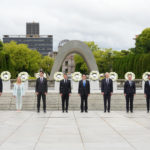Hiroshima Report 2024Special Feature G7 Hiroshima Summit
The G7 Summit in Hiroshima in May 2023 adopted the “G7 Leaders’ Hiroshima Vision on Nuclear Disarmament” (hereafter “Hiroshima Vision”), which was the “first G7 Leaders’ document with a particular focus on nuclear disarmament.”1
The Hiroshima Vision commenced with a reference to the devastating impact of nuclear weapons, stating: “We, the Leaders of the G7, met at a historical juncture in Hiroshima, which together with Nagasaki offers a reminder of the unprecedented devastation and immense human suffering the people of Hiroshima and Nagasaki experienced as a result of the atomic bombings of 1945.” Subsequently, the G7 leaders “reaffirm[ed] … [their] commitment to achieving a world without nuclear weapons with undiminished security for all.”
The G7 leaders also “underscore[d] the importance of the 77-year record of non-use of nuclear weapons,” and stated that “Russia’s irresponsible nuclear rhetoric, undermining of arms control regimes, and stated intent to deploy nuclear weapons in Belarus are dangerous and unacceptable.” In addition, they “affirm[ed] that a nuclear war cannot be won and must never be fought.” At the same time, they mentioned that “[their] security policies are based on the understanding that nuclear weapons, for as long as they exist, should serve defensive purposes, deter aggression and prevent war and coercion.”
Subsequently, G7 leaders stated that “[t]he overall decline in global nuclear arsenals achieved since the end of the Cold War must continue and not be reversed.” They reaffirmed that the Nuclear Non-Proliferation Treaty (NPT) is the cornerstone of the international nonproliferation regime, and also “reaffirm[ed] [their] commitment to the ultimate goal of a world without nuclear weapons with undiminished security for all, achieved through a realistic, pragmatic and responsible approach.” In this context, the G7 leaders “call[ed] on Russia to enable a return to full implementation of the [New Strategic Arms Reduction Treaty (New START)],” and expressed their concern that “China’s accelerating build-up of its nuclear arsenal without transparency nor meaningful dialogue poses a concern to global and regional stability.”
Regarding transparency, the G7 leaders “welcome[d] actions already taken by the United States, France and the United Kingdom to promote effective and responsible transparency measures through providing data on their nuclear forces and the objective size of their nuclear arsenal” They, inter alia “call[ed] on nuclear-weapon States that have not yet done so to follow suit,” and “to engage with non-nuclear-weapon States in a meaningful dialogue on transparency regarding their nuclear arsenals and limiting nuclear competition.” While “stress[ing] the benefit of prenotification of relevant strategic activities,” the G7 leaders “recognize[d] the need for concrete steps by nuclear-weapon States to reduce strategic risks,” and called for substantial engagement by China and Russia in multilateral and bilateral forums.
As for multilateral nuclear disarmament, the G7 leaders called for the immediate commencement of negotiations on a Fissile Material Cut-off Treaty (FMCT), although they did not explicitly say that the Conference on Disarmament should be the negotiating forum. They also called on “all states that have not yet done so to declare and maintain voluntary moratoria on the production of fissile material for use in nuclear weapons or other nuclear explosive devices.”
On the Comprehensive Nuclear-Test-Ban Treaty (CTBT), the G7 leaders argued that nuclear explosion tests should not be conducted, and condemned any threats to carry them out. They also “emphasize[d] that bringing the [CTBT] into force is … [an] urgent matter,” and “call[ed] on all states to declare new or maintain existing moratoriums on nuclear weapon test explosions or any other nuclear explosions.” In addition, they underscored the role of the CTBT Organization (CTBTO) Preparatory Commission, and called for the provision of sufficient resources to ensure the continuous operation and long-term sustainability of its verification regime.
In terms of nuclear nonproliferation, the G7 leaders “reiterate[d] [their] unwavering commitment to the goal of North Korea’s complete, verifiable, and irreversible abandonment of its nuclear weapons and existing nuclear programs, and any other weapons of mass destruction (WMD) and ballistic missile programs in accordance with relevant UN Security Council Resolutions (UNSCRs),” and reaffirmed that “North Korea cannot and will never have the status of a nuclear-weapon State under the NPT.” On Iran, they were “deeply concerned about Iran’s unabated escalation of its nuclear program,” and they called on Iran to, inter alia, cease nuclear escalation, fulfill its legal obligations and political commitments regarding nuclear nonproliferation, and uphold its safeguards obligations and commitments. They also stated that a diplomatic solution remained the best way forward and that the Joint Comprehensive Plan of Action (JCPOA) “continue[d] to provide a useful reference.”
In addition, G7 leaders “urge[d] all states to take their responsibilities seriously to meet the highest standards of safeguards, safety, and security in promoting the peaceful uses of nuclear energy, science, and technology.” They also “reaffirm[ed] the importance of the implementation of the highest standards of safeguards of the [International Atomic Energy Agency (IAEA)] and the universal adoption of the Additional Protocol (AP) as fundamental components of the nuclear nonproliferation regime,” and “support[ed] further discussions within the Nuclear Suppliers Group (NSG) towards the establishment of the AP as a condition of supply in the Group’s guidelines.”
Furthermore, the G7 leaders stated that transparency in the management of civilian-use plutonium must be maintained, and “oppose[d] any attempt to produce or support the production of plutonium for military programs under the guise of civilian programs, which undermines the objectives of the NPT including the promotion of peaceful uses of nuclear energy.” They called for reporting annually holdings of all plutonium stockpiles in peaceful nuclear activities to the IAEA in accordance with the Guidelines for the Management of Plutonium. The G7 leaders also mentioned “the need to manage civil stocks of highly enriched uranium,” as well as a commitment to efforts to reduce the production and accumulation of weapon-usable nuclear materials for civilian purposes.
Finally, in their “Hiroshima Vision,” the G7 leaders argued that it is necessary to undertake “a global effort to take us from the harsh reality to the ideal”; “underscore[d] the importance of disarmament and non-proliferation education and outreach”; and “encourage[d] other leaders, youth and people from around the world to visit Hiroshima and Nagasaki to raise and sustain awareness of the realities of nuclear weapons use one can witness in Hiroshima and Nagasaki.” They also welcomed the initiatives that “support the full, equal, and meaningful participation of women in addition to the engagement of civil society in disarmament and nonproliferation processes.”
Contrary to the “Hiroshima Vision,” which received mixed reactions, the event that conveyed the reality of the atomic bombing was widely recognized as profoundly significant. As mentioned above, the Hiroshima Vision was the first G7 Leaders’ document with a particular focus on nuclear disarmament, and it was recognized as an important achievement that the G7 leaders, including the three nuclear-weapon states (NWS), reaffirmed their commitment to a “world without nuclear weapons,” referring to “the unprecedented devastation and immense human suffering” caused by the atomic bombings. Prime Minister Fumio Kishida stated in a press conference, “[The Hiroshima Vision] holds historical significance as it powerfully demonstrates the G7 leaders’ resolve, concrete agreements, future priorities, and direction towards the realization of a world without nuclear weapons.”2
On the other hand, the Hiroshima Vision was criticized for not presenting a concrete path or roadmap towards a world without nuclear weapons, and there was little mention of efforts or measures undertaken in this regard by the G7 countries, particularly the three NWS. Furthermore, there was strong criticism, especially from atomic bomb survivor groups and peace movement organizations that inclusion of the sentence, “[their] security policies are based on the understanding that nuclear weapons, for as long as they exist, should serve defensive purposes, deter aggression and prevent war and coercion,” meant their positive reaffirmation of the existence of nuclear weapons and nuclear deterrence.
The Chugoku Shimbun, a local newspaper based in Hiroshima, criticized the Hiroshima Vision as “extremely unsatisfactory,” and asserted that it was “unfit to bear the name of Hiroshima, a city where many atomic bomb victims rest,” and “unforgivable for not touching upon the Treaty on the Prohibition of Nuclear Weapons (TPNW).” Similarly, the Nagasaki Shimbun also commented, “Prime Minister Fumio Kishida talks about bringing harsh realities closer to ideals. In light of this, we want more decisive actions.”3 During the G7 Hiroshima Summit, the G7 leaders visited the Peace Memorial Museum, spoke with atomic bomb survivors, and offered flowers at the Cenotaph for the Atomic Bomb Victims.
After the visit to Peace Memorial Museum, the G7 leaders signed and wrote in the guest book.4 Prime Minister Kishida commented on these series of events, saying, “In Hiroshima, a city that suffered devastating damage from the atomic bomb and then achieved remarkable reconstruction, I shared a solemn moment with the G7 leaders as we confronted the reality of the atomic bombing. I believe this was historic, from the perspective of demonstrating our determination to the world for a world without nuclear weapons.”5
Leaders of the invited countries (Australia, Brazil, Comoros [African Union Chair], Cook Islands [Pacific Islands Forum Chair], India [G20 Presidency], Indonesia [ASEAN Chair], South Korea and Vietnam), representatives of international organizations (United Nations (UN), International Monetary Fund (IMF), World Bank, World Trade Organization (WTO), Organization for Economic Co-operation and Development (OECD), and International Energy Agency (IEA)), and President Volodymyr Zelenskyy of Ukraine (participating as a guest in the Ukraine session during the latter half of the Summit) also visited the Peace Memorial Museum, engaged in dialogue with atomic bomb survivors, and laid flowers at the Cenotaph for the Atomic Bomb Victims. Additionally, Prime Minister Kishida and President Yoon Suk Yeol of South Korea laid flowers at the Cenotaph for the Victims of the Korean Atomic Bombing.
1 “G7 Leaders’ Hiroshima Vision on Nuclear Disarmament,” May 19, 2023, https://www.g7hiroshima. go.jp/documents/pdf/230520-01_g7_en.pdf.
2 “Press Conference on Impressions after the First Day of the G7 Hiroshima Summit,” Prime Minister’s Office of Japan, May 19, 2023, https://www.kantei.go.jp/jp/101_kishida/statement/2023/0519bura.html. (in Japanese)
3 “Discussions on nuclear abolition ‘not enough’ at G7 summit in Hiroshima,” Japan Newspaper Publishers & Editors Association, June 23, 2023, https://www.pressnet.or.jp/publication/shimen/ 230613_15048.html. (in Japanese)
4 “G7 Leaders’ Visit to the Hiroshima Peace Memorial Museum (Guest Book Entries) G7 Leaders’ Visit to the Hiroshima Peace Memorial Museum (Guest Book Entries),” May 20, 2023, https://www. mofa.go.jp/ms/g7hs_s/page1e_000682.html.
5 “Press Conference on Impressions after the First Day of the G7 Hiroshima Summit.” (in Japanese)








